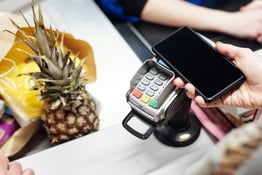In the weeks leading up to the 2023 Super Bowl, Chook, a fast-casual with four locations in the Denver area, decided it’d use the event to incentivize its staff. The cashier who sold the most chicken slider party packs would receive a $100 cash card.
“Throughout the pandemic, restaurants lost their ‘funness’ in a lot of ways, and this seemed like a good way to incentivize employees, create a little friendly competition, and reward high performers in tangible ways that are obviously still good for the business,” says Chook’s chief operating officer Elizabeth Nicholson.
Staff were excited to participate, says Nicholoson. And the contest also encouraged staff to engage more with guests, opening up opportunities to ask about their Super Bowl plans and remind them about the party options that Chook offers. In the end, Chook saw a roughly 25% increase in party pack sales compared to the last Super Bowl. Nicholson says she’s already planning Chook’s next employee incentive campaign.
“These kinds of contests incentivize our staff to be our marketers, and that’s going to go much farther than putting money into a Google ad, direct mailer, or billboard,” says Nicholson.
Chook is just one among many restaurants that started offering employee incentive programs in recent years. It’s a trend largely driven by a desire to retain staff amid a competitive market. And as with Chook, many restaurants say it’s paying off.
If you’re on the fence about investing in your own program, we break down some of the benefits to consider. Plus, we’ll walk you through how to get started and strategies to drive the greatest return on investment.
Benefits of an employee incentive program
Who doesn’t love an opportunity to earn more money? Employee incentive programs bring the potential to boost staff retention and workplace satisfaction.
“Staff get the actual experience of working towards a goal and achieving that goal, which can fight against that feeling of burnout for a lot of restaurant workers,” says Andrew Duffy, CEO of SparkPlug, an incentive management platform. “Your employees also get to make more money, but the nice thing is that they can do so in a way that’s ultimately cost beneficial to the restaurant.”
Nicholson sees incentives as a training tool. Contests become an opportunity for staff to learn about different aspects of the business, while you as an operator can drive employees to focus on specific goals.
“We can teach, ‘What is an upsell?’, or ‘What’s the story behind our dishes?’, or about wine pairings and how our employees can use that to sell more wine,” says Nicholson.
Crafting an employee incentive program that drives participation and revenue
There are two elements to a successful employee incentive campaign:
Staff actually want to participate in it.
There’s a clear return on investment.
Let’s dive into the steps you need to take in order to achieve these goals.
Step 1: Identify your restaurant’s current pain points. Every incentive campaign should be crafted with a strategic goal in mind. This requires you to examine where there’s room for improvement in your current operations. Do you want to increase table turns or ticket averages or loyalty program sign-ups? Are you already working to decrease food waste or ticket times? Examine your pain points, along with your overall business goals, and start generating contest ideas from there.
Step 2: Decide between a team vs. individual campaign.
This decision often depends on your goals for the campaign, but some challenges can work both ways. For example, if the goal is to increase ticket averages during lunch service, you could have the entire front of house team work together to surpass a certain ticket average within two weeks. Or you could reward the top server who averages the highest check totals within that same time period.
“What’s the tone of your restaurant? Is it a team environment where everyone’s working together, and there’s already a lot of collaboration?” says Duffy. “It’s really an attitude thing, and often you have to test out different options to see what’s going to get you the best results.”
Step 3: Set a strategic timeline for the campaign.
One week to one month – that’s generally the sweet spot for the duration of a contest.
“You want to give staff time to become aware of the incentive and then start to get in the practice of actually performing on it,” says Duffy. “Maybe the first week they're learning what their talk tracks will be for trying to get a table to order an appetizer, and then by the second or third weeks, they're really running with it and using the strategies that they've learned.”
Run the contest for longer than a month, however, and you’re likely to lose momentum and excitement. Occasionally, you might even execute a super short, one-day incentive campaign, like rewarding staff on Valentine’s Day only for upselling wine. Try to align the incentives with the time and effort required.
Step 4: Determine the incentive and how much you’ll offer.
Pizza party or cash? Choose the latter incentive, and you can almost guarantee that your staff will work harder towards the business goals you’ve set forth.
“Unless you can offer a reward that’ll make a real, relevant impact to your staff’s day-to-day life – like gifting the best parking spot for a month – always go with cash,” says Duffy.
Choosing the amount of cash to offer requires drilling into your data. You need to understand your margins in order to offer an incentive that’s both enticing to your staff but doesn’t cost you more than you’re making.
“It’s totally fine to start small and then increase until you find that point where folks start to get engaged,” says Duffy. “What you don't want to do is start high and then walk back because that can be demotivating. It’s like, ‘I was getting $2 per unit and now I'm getting 50 cents per unit? That doesn't really excite me in the same way that it did previously.’”
If you’re on a tight budget, consider leveraging your vendors to sponsor incentives. For example, maybe you create a contest to sell more chicken wings, and your vendor pays for the employee reward. “Often vendors are excited to do that because that's one of the best ways to increase volume and create reliable relationships,” says Duffy.
Step 5: Create a plan to promote the campaign to employees.
Often the determining factor for success is simply making sure you’re keeping the contest top of mind for staff. Announce contests at the top of every shift meeting, and consider using an incentive management platform to further spread the word.
“Our platform sends out continuous text updates to the employees, and it’ll link them to a dashboard where they can see where they stand in a competition,” says Duffy. “There's a really big boost in attention and excitement that comes from recurring notifications, which ultimately allows you to spend less on the incentives but get the same results.”
Step 6: Determine how you’ll keep track of the campaign + consider an incentive management platform.
You can manually keep track of campaigns using POS data and a spreadsheet or book and incorporate the rewards into your payroll. But here’s where technology also largely comes in hand.
Most incentive management platforms integrate with your point of sale, enabling you to automate the tracking of performance incentives. With Sparkplug, for example, the platform tracks who's selling what and aggregates the rewards that staff are owed. Staff can redeem rewards directly from the platform.
“Honestly, without technology, I think it might be a big hassle,” says Nicholson, who uses Sparkplug to run contests at Chook. “There’s also the opportunity to have vendors co-sponsor the campaigns, so it’s less dollars that we actually put towards it.”
There are a wide array of incentive management platforms. For an easier setup, look for a platform that specializes in restaurant and retail management.
5 employee incentive contest ideas
There are an endless number of employee incentive campaigns you can use to motivate employees. We encourage you to get creative depending on your own business goals. But as a starting point, we’ve laid out a few fundamental contest goals and ideas to consider.
High-margin upsells: Want a really reliable way to increase your revenue? Craft contests around upselling higher-margin items. This can include encouraging staff to sell a certain appetizer, dessert, or drink. Example: Reward $100 to the employee who sells the most nachos over the course of a month.
Quicker table turns: Here’s a goal where you can include the whole team, including the back of house through incentivizing decreased ticket times. Example: If the restaurant decreases average table-turn times by 10% over the course of a month, reward participating employees a $20 bonus.
Higher ticket averages: This goal aims to increase both upsells and add-ons. Example: If the front of house team increase the average ticket at the restaurant from $50 to $60 over the course of three weeks, everybody gets $X reward.
Positive customer review contest: This goal encourages FOH staff to elevate the customer dining experience, while also pulling in reviews that serve as positive marketing for your restaurant. Example: Have staff encourage customers to leave a post-dining review on Yelp or Google. Staff should share their name with customers and ask them to include it in the review. Then, reward the top three employees who get the most five-star reviews within a month.
Sponsored vendor contests: Teaming up with vendors on sales contests can be a win-win situation. It allows you to motivate staff, give them the opportunity to earn more, and potentially increase retention, without you having to invest as much money in rewards. Meanwhile, the vendor reaps the benefit of higher sales and relationship-building. In some scenarios, you might choose to also contribute prize money along with the vendor to create an even more enticing reward for staff. Example: Team up with an alcohol vendor to create a cocktail special. The top two employees who sell the most within two weeks win X amount of money.





